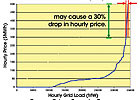
“Hockey stick” pricing could assist you with your net savings goals.
Some power customers are being paid to reduce load when called upon by utilities and/or grid operators. Such “demand response” (DR) is one of the fastest developing ways to address growing system-wide peak load and constrain price spikes. But who’s making - and who’s saving - the millions of dollars being spent to snip off those peaks?
Source of The Problem
For a variety of reasons, the margin between installed generating capacity and peak demand has narrowed. In many states, few (or no) new power plants have been built in recent years. At the same time, pressure continues to shut down or minimize use of coal-fired power plants due to their higher emissions. As a result, many new plants are natural gas-fired peaking units. As gas prices rise, those peakers set the hourly wholesale prices paid to all generators, which (in some areas) may approach $1,000 per MWh (i.e., $1.00/kWh).Based on the “hockey stick” shape (Figure 1) of wholesale hourly power pricing curves, even a small reduction in peak demand holds the potential for a large drop in hourly pricing. On very hot days for example, a 1% reduction in load could yield a 30% drop in the hourly price. Even where power prices are regulated, that price impact (up or down) may flow through to retail power bills via a monthly fuel (or energy) adjustment charge, or as part of a varying electric rate.
Is There A DR In The House?
Starting several years ago, utilities and grid operators started paying retail power customers in at least 30 states to participate in grid management, instead of merely responding toad hoccalls. Many retail customers have received “free” money (paid by all ratepayers via their electric bills) by allowing DR providers to monitor their power use and (maybe) install demand limiting devices at their facilities. A customer owning a qualifying backup generator may be paid merely for agreeing to run it if called upon - even it such a call is never made.While programs (and payoffs) vary considerably among grids and zones, a participating customer could see payments from a few to many thousands of dollars a year. One large industrial user in a DR program cut his annual electric bill by 13%.
Wave Money And They Will Come
A load response mini-industry has grown up around such programs. DR providers now aggregate automated customer load reduction capability and offer it as a service to power marketers, grid operators, and utilities.Where central residential air conditioning is common, for example, a DR firm remotely controls radio-operated thermostats that cycle compressors in groups for short periods, thus reducing overall load while only minimally impacting comfort. As is true for almost any program, however, some less desirable approaches have been taken to squeeze money out of the grid capacity problem.
Gaming The System
Some DR providers have been taking advantage of loose rules and contractual chicanery to secure large fees for doing little beyond number juggling. A few DR providers found ways to collect for non-existent demand reductions, while others have charged customers when no demand response calls occurred. In other cases, customers found themselves giving up the lion’s share of the benefits without realizing that they don’t need a DR provider to participate.Those loose rules may now be changing. Grid operators are setting higher demand call thresholds, and may be requiring more frequent reporting of users’ power usage patterns. Some customers are beginning to realize that they can make more from their systems without having a DR provider as their partner.



